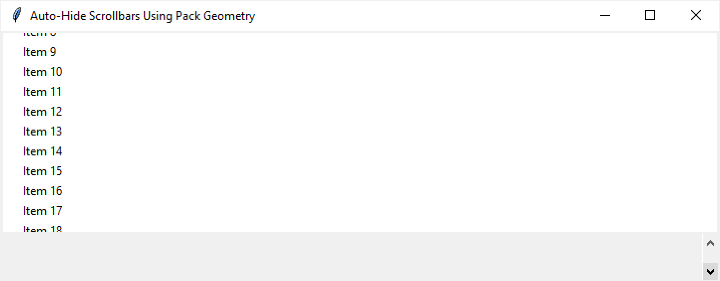
 Data Structure
Data Structure Networking
Networking RDBMS
RDBMS Operating System
Operating System Java
Java MS Excel
MS Excel iOS
iOS HTML
HTML CSS
CSS Android
Android Python
Python C Programming
C Programming C++
C++ C#
C# MongoDB
MongoDB MySQL
MySQL Javascript
Javascript PHP
PHP
- Selected Reading
- UPSC IAS Exams Notes
- Developer's Best Practices
- Questions and Answers
- Effective Resume Writing
- HR Interview Questions
- Computer Glossary
- Who is Who
Create autohide Tkinter canvas scrollbar with pack geometry
Tkinter, a standard GUI toolkit for Python, provides a versatile set of tools for building graphical user interfaces. When working with large amounts of data or content in a Tkinter Canvas, implementing scrollbars becomes crucial for effective navigation. In this article, we will explore the concept of auto-hide scrollbars in a Tkinter Canvas, specifically using the pack geometry manager. Auto-hide scrollbars enhance the user experience by appearing only when needed, providing a clean and uncluttered interface.
Concept of Auto-Hide Scrollbars
Auto-hide scrollbars are a user-friendly feature that dynamically adjusts scrollbar visibility based on the content within the Tkinter Canvas. The goal is to display the scrollbar only when the content exceeds the visible area, optimizing screen space and reducing visual distractions. Achieving this functionality involves monitoring the canvas dimensions and intelligently toggling scrollbar visibility. The pack geometry manager in Tkinter allows for straightforward organization and placement of widgets, making it a suitable choice for implementing auto-hide scrollbars.
Step-by-Step Implementation
Let's check out the implementation of auto-hide scrollbars in a Tkinter Canvas using the pack geometry manager.
Step 1: Setting up the Tkinter Canvas
Let's begin by creating a Tkinter window with a Canvas widget using the pack geometry manager. We'll configure the canvas with a scroll region, add horizontal and vertical scrollbars, and bind their visibility to canvas dimensions. Additionally, we'll set up event bindings to trigger actions on canvas resize events or mouse wheel scrolls.
import tkinter as tk
def on_canvas_configure(event):
----------
----------
def check_scrollbar_visibility():
----------
----------
def on_mousewheel(event):
----------
----------
# Create Tkinter window
root = tk.Tk()
root.title("Auto-Hide Scrollbars Using Pack Geometry")
# Set window dimensions
root.geometry("720x250")
# Create a canvas
canvas = tk.Canvas(root, bg="white", width=300, height=200, scrollregion=(0, 0, 500, 500))
canvas.pack(expand=True, fill="both")
# Create vertical scrollbar
y_scrollbar = tk.Scrollbar(root, orient="vertical", command=canvas.yview)
# Create horizontal scrollbar
x_scrollbar = tk.Scrollbar(root, orient="horizontal", command=canvas.xview)
# Configure canvas to use the scrollbars
canvas.configure(yscrollcommand=y_scrollbar.set, xscrollcommand=x_scrollbar.set)
# Bind events
canvas.bind("<Configure>", on_canvas_configure)
canvas.bind("<MouseWheel>", on_mousewheel)
# Initial check for scrollbar visibility
check_scrollbar_visibility()
# Add some content to the canvas
for i in range(50):
canvas.create_text(20, 20 * i, text=f"Item {i+1}", anchor="w")
# Start the Tkinter event loop
root.mainloop()
Step 2: Implementing Auto-Hide Scrollbars
The core of auto-hide scrollbars lies in dynamically determining when to show or hide them based on the canvas content. The on_canvas_configure function updates the scroll region on canvas resize events, and check_scrollbar_visibility intelligently toggles scrollbar visibility based on canvas dimensions versus content size.
def on_canvas_configure(event):
canvas.configure(scrollregion=canvas.bbox("all"))
check_scrollbar_visibility()
def check_scrollbar_visibility():
# Check and set visibility for vertical scrollbar
if canvas.winfo_reqheight() < canvas.winfo_height():
y_scrollbar.pack_forget() # Hide the scrollbar
else:
y_scrollbar.pack(side="right", fill="y")
# Check and set visibility for horizontal scrollbar
if canvas.winfo_reqwidth() < canvas.winfo_width():
x_scrollbar.pack_forget() # Hide the scrollbar
else:
x_scrollbar.pack(side="bottom", fill="x")
Step 3: Handling User Interaction
To enhance user interaction, we've implemented scrolling capabilities using the mouse wheel. The on_mousewheel function is bound to the Canvas widget, allowing users to scroll vertically with the mouse wheel.
def on_mousewheel(event): canvas.yview_scroll(-1 * (event.delta // 120), "units")
Step 4: Starting the Tkinter event loop
At last, we need to start the Tkinter event loop as follows
root.mainloop()
Example
Let's put these steps all together to get the complete implementation code
import tkinter as tk
def on_canvas_configure(event):
canvas.configure(scrollregion=canvas.bbox("all"))
check_scrollbar_visibility()
def check_scrollbar_visibility():
# Check and set visibility for vertical scrollbar
if canvas.winfo_reqheight() < canvas.winfo_height():
y_scrollbar.pack_forget() # Hide the scrollbar
else:
y_scrollbar.pack(side="right", fill="y")
# Check and set visibility for horizontal scrollbar
if canvas.winfo_reqwidth() < canvas.winfo_width():
x_scrollbar.pack_forget() # Hide the scrollbar
else:
x_scrollbar.pack(side="bottom", fill="x")
def on_mousewheel(event):
canvas.yview_scroll(-1 * (event.delta // 120), "units")
# Create Tkinter window
root = tk.Tk()
root.title("Auto-Hide Scrollbars Using Pack Geometry")
# Set window dimensions
root.geometry("720x250")
# Create a canvas
canvas = tk.Canvas(root, bg="white", width=300, height=200, scrollregion=(0, 0, 500, 500))
canvas.pack(expand=True, fill="both")
# Create vertical scrollbar
y_scrollbar = tk.Scrollbar(root, orient="vertical", command=canvas.yview)
# Create horizontal scrollbar
x_scrollbar = tk.Scrollbar(root, orient="horizontal", command=canvas.xview)
# Configure canvas to use the scrollbars
canvas.configure(yscrollcommand=y_scrollbar.set, xscrollcommand=x_scrollbar.set)
# Bind events
canvas.bind("<Configure>", on_canvas_configure)
canvas.bind("<MouseWheel>", on_mousewheel)
# Initial check for scrollbar visibility
check_scrollbar_visibility()
# Add some content to the canvas
for i in range(50):
canvas.create_text(20, 20 * i, text=f"Item {i+1}", anchor="w")
# Start the Tkinter event loop
root.mainloop()
This example demonstrates a Tkinter window with a canvas, both vertical and horizontal scrollbars, and functions to check and adjust the visibility of the scrollbars based on the canvas content.
Output

Conclusion
In summary, incorporating auto-hide scrollbars into a Tkinter Canvas using the pack geometry manager provides an elegant solution for crafting intuitive and space-efficient interfaces. The step-by-step guide, accompanied by Python code, has shed light on the implementation details, emphasizing the synergy between Tkinter and pack geometry. By adopting this approach, developers can seamlessly optimize screen real estate, resulting in a refined and user-centric experience for Tkinter applications. This dynamic scrollbar solution not only simplifies navigation through extensive content but also contributes to a polished and visually pleasing graphical user interface.

